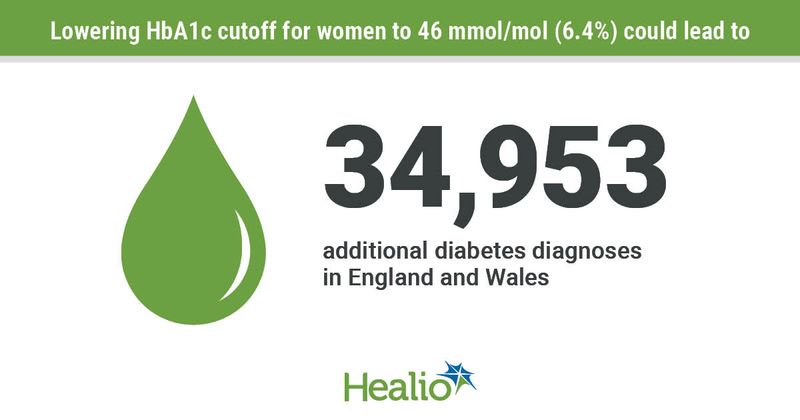HbA1c cutoff for diagnosing diabetes likely too high for premenopausal women
Click Here to Manage Email Alerts
Key takeaways:
- Women younger than 50 years without diabetes have an HbA1c 1.6 mmol/mol lower than men.
- Researchers suggest lowering the HbA1c cutoff for diagnosing diabetes for premenopausal women to 46 mmol/mol (6.4%).
The HbA1c cutoff for diagnosing women younger than 50 years with diabetes may need to be lower than the cutoff for men, according to study findings.
The distribution of HbA1c levels among healthy adults younger than 50 years in England and Wales was 1.6 mmol/mol lower for women compared with men, researchers observed in data presented at the European Association for the Study of Diabetes annual meeting and simultaneously published in Diabetes Therapy.

“The threshold for diagnosis of diabetes mellitus may be too high by approximately 2 mmol/mol in women under the age of 50, which may result in 17% of all premenopausal women missing their diabetes mellitus diagnosis,” Adrian H. Heald, MD, consultant at Salford Royal Hospital in the U.K. and lecturer at the University of Manchester, and colleagues wrote. “We estimated that for England and Wales, moving the threshold for diagnosis of diabetes mellitus to 46 mmol/mol (HbA1c 6.4%) from 48 mmol/mol (HbA1c 6.5%) would reclassify approximately 35,000 women as having diabetes mellitus.”

Researchers obtained HbA1c measurements from 146,907 adults without diabetes who had a single HbA1c measurement taken between 2012 and 2019 at the North Midlands NHS Trust clinical biochemistry department. The same data were also collected from 938,678 adults who had a single HbA1c measurement between 2019 and 2021 at six other sites. HbA1c values were analyzed separately among men and women and for adults younger than 50 years and those aged 50 years and older.
Among adults younger than 50 years who had HbA1c measured at North Midlands NHS Trust, women had a 1.6 mmol/mol lower HbA1c than men (P < .0001). Women aged 50 years and older had a 0.9 mmol/mol lower HbA1c than men aged 50 years and older (P < .0001). In a separate analysis of the 938,678 adults who had HbA1c measured at six other sites, similar findings were observed.
Researchers projected the impact of lowering the threshold of a diabetes diagnosis from 48 mmol/mol to 46 mmol/mol among 43,253 women aged 16 to 50 years in the North Midlands NHS Trust group. There were 113 women, or 0.26% of the group, who had an HbA1c value of 46 mmol/mol or 47 mmol/mol and would have been diagnosed with diabetes if the cutoff were lowered. Extrapolating that percentage to the population of England and Wales, lowering the HbA1c cutoff could lead to 34,953 additional women being diagnosed with diabetes in those countries.
“We acknowledge that the logistics of changing the diagnostic cutoff for HbA1c in this group of women may be challenging,” the researchers wrote. “One alternative approach may be to offer further assessment using fasting plasma glucose or oral glucose tolerance testing in those with HbA1c values of 46 mmol/mol or 47 mmol/mol. We accept that any such categorization based on HbA1c is always an approximation, but if the targeting of therapy to optimize cardiovascular risk factor profile improves life quality and expectancy, such a reclassification will prove to have been worthwhile.”
Reference:
Holland D, et al. Diabetes Ther. 2023;doi:10.1007/s13300-023-01482-6.

